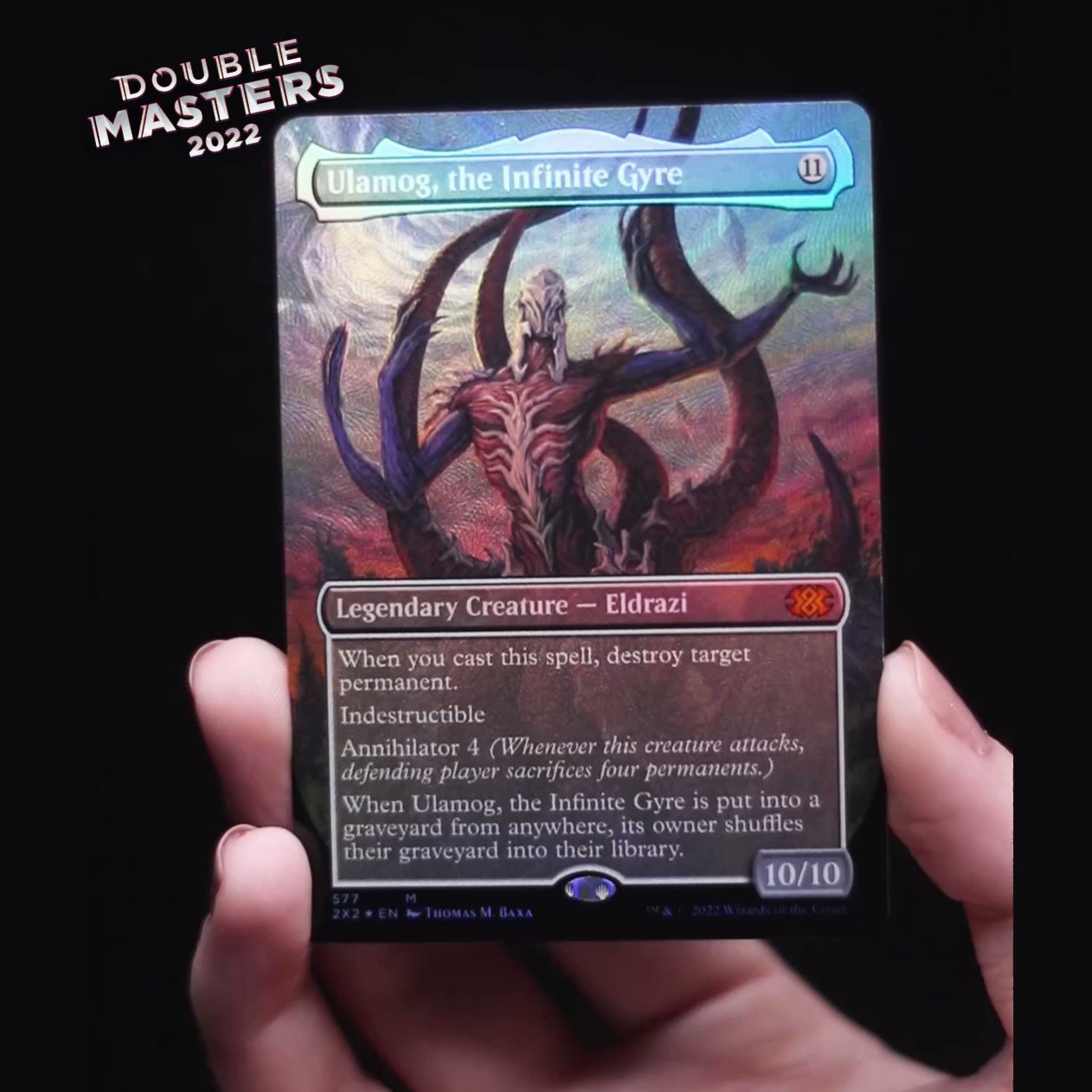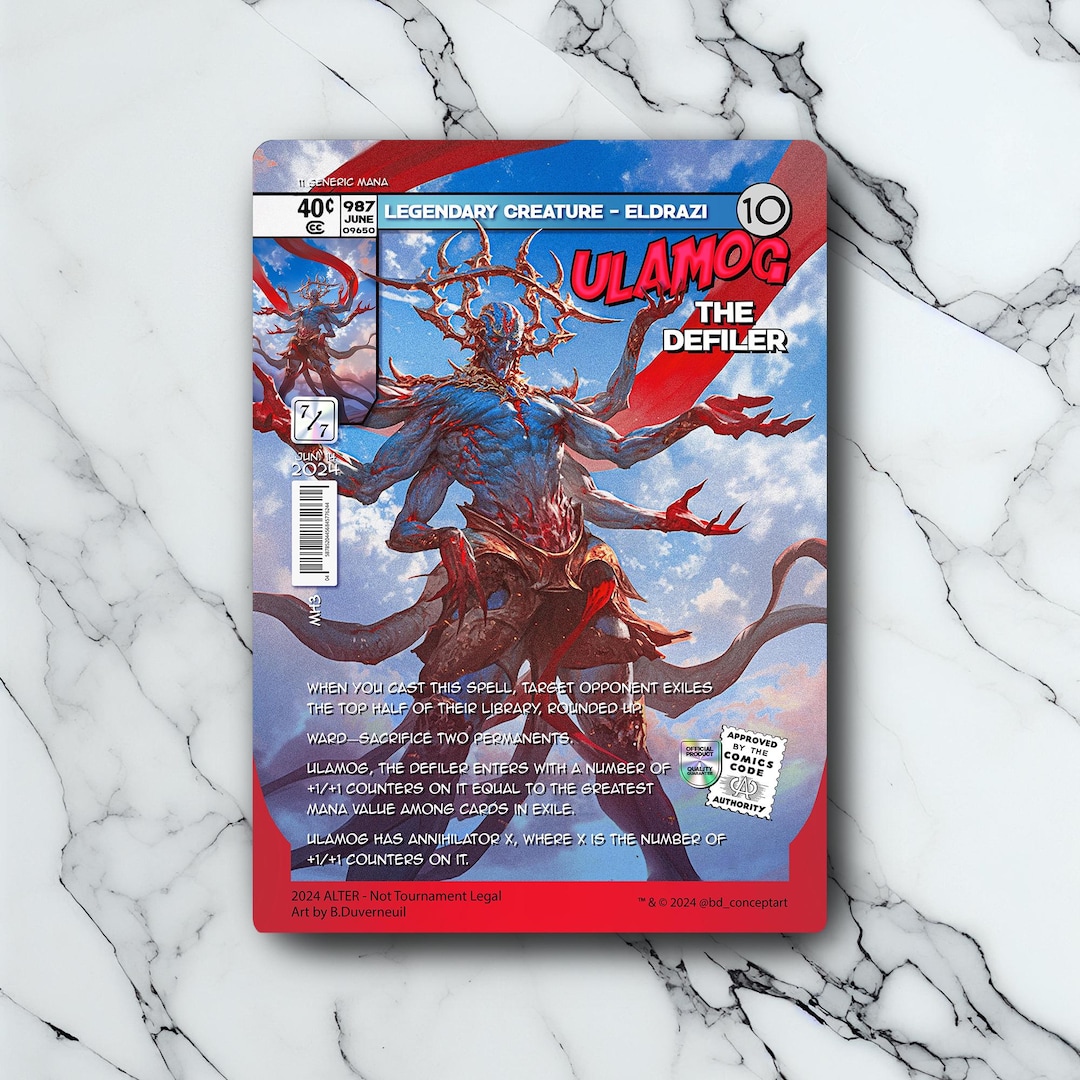MTG's Ulamog Full Art: The Ultimate Guide & Why It's So Iconic!
Ever wondered what makes a single piece of cardstock so captivating, so sought after that it transcends its utilitarian purpose? The answer lies in the immersive art and strategic depth encapsulated within "Ulamog, the Ceaseless Hunger" and, more specifically, its full art rendition.
This exploration journeys into the multifaceted realm of Ulamog, dissecting its genesis, its profound influence on gameplay dynamics, and the compelling allure of its full art manifestation. Whether you're a battle-hardened veteran of the Magic: The Gathering arena or a fledgling explorer navigating the intricate landscapes of trading card games, comprehending the significance of Ulamog's full art is not merely beneficialit's essential. This understanding unlocks a deeper appreciation for the artistry, strategy, and narrative interwoven within each card, transforming a simple game into a rich tapestry of imagination and competitive spirit.
Ulamog, the Ceaseless Hunger, stands as a monumental figure within the Magic: The Gathering universe, an Eldrazi titan whose very presence warps reality. The full art version isn't just a card; it's a statement piece. It's a visceral representation of immense power and unfathomable hunger. The release of this full art variant ignited a fervent passion among collectors and players alike, presenting a visually arresting interpretation of this legendary entity. More than just aesthetic appeal, the full art Ulamog serves as a symbol, representing a pinnacle of card design and artistic expression within the MTG community. Its value extends beyond mere monetary worth; it embodies a piece of the game's history, a snapshot of a key character, and a testament to the enduring appeal of the Eldrazi titans.
The saga of Ulamog begins with the Eldrazi, ancient and unfathomable beings from beyond the known multiverse. These titans, Ulamog among them, are not merely creatures but forces of nature, embodying entropy and devastation. They consume entire planes, leaving behind barren wastelands devoid of life. Ulamog, along with Kozilek and Emrakul, represent different facets of this destructive force. While Kozilek embodies distortion and Emrakul represents mutation, Ulamog is the embodiment of ceaseless hunger, a consuming void that devours everything in its path. Their arrival on the plane of Zendikar nearly spelled its doom, and their subsequent containment and eventual release have shaped the narrative of Magic: The Gathering in profound ways.
Understanding Ulamog's significance necessitates a dive into its gameplay mechanics. As a card, Ulamog is a game-changer. Its high mana cost is offset by its devastating abilities. Upon being cast, it exiles two target permanents, immediately disrupting the opponent's board state. Its indestructible nature makes it incredibly difficult to remove, and its attack triggerexiling the top twenty cards of the defending player's librarycan quickly decimate their resources. Ulamog's presence on the battlefield demands an immediate response, often forcing opponents into desperate measures to avoid its wrath. This power and resilience make it a staple in many competitive decks, particularly those focused on ramp strategies that allow for the early casting of high-cost creatures.
Ulamog, though often referred to as a singular entity, is more accurately understood as a network, a vast and interconnected being that extends its influence across entire planes. The smaller Eldrazi creatures seen throughout the game are extensions of these titans, acting as drones that consume and prepare the way for their masters. This concept of a hive mind further emphasizes the overwhelming power of the Eldrazi and the futility of resistance against them. When Ulamog appears, it's not just a single creature that's threatening the world; it's an entire ecosystem of destruction, an inexorable force that reshapes reality in its image.
The full art version of Ulamog amplifies these concepts. The artwork often depicts Ulamog as a colossal, otherworldly being, its form defying conventional anatomy and logic. Tendrils of energy reach out from its body, consuming landscapes and warping reality. The color palette is often dominated by desolate hues, reflecting the barren wastelands that follow in its wake. These artistic choices are not arbitrary; they are deliberate attempts to convey the Eldrazi's alien nature and their devastating impact on the multiverse. The full art rendition allows players to experience the scale and horror of Ulamog in a way that the standard card frame simply cannot capture. It transforms the card from a mere game piece into a work of art, a visual representation of a terrifying and awe-inspiring force.
Artistic interpretations of Ulamog have evolved over time, reflecting the changing narrative and visual style of Magic: The Gathering. Early depictions often focused on the creature's monstrous appearance, emphasizing its jagged limbs and grotesque features. As the game's lore deepened, the artwork began to explore the Eldrazi's alien nature, depicting them as beings beyond human comprehension. The full art versions represent the culmination of this artistic evolution, showcasing the titans in all their terrifying glory. These depictions are not merely illustrations; they are visual narratives, telling the story of the Eldrazi's arrival on Zendikar and their subsequent impact on the multiverse. They are also testaments to the skill and creativity of the artists who bring these creatures to life, transforming abstract concepts into tangible and unforgettable images.
The strategic applications of Ulamog in competitive play are varied and complex. It often serves as a finisher in ramp decks, providing a game-ending threat that is difficult to answer. Its exile ability can remove key threats from the opponent's board, disrupting their strategy and paving the way for a decisive victory. In Commander, Ulamog is a popular choice for leading Eldrazi-themed decks, providing a powerful and resilient commander that can quickly overwhelm opponents. Its high mana cost is less of a drawback in this format, where games tend to be longer and mana ramp is more prevalent. The full art version of Ulamog is particularly prized in Commander, serving as a status symbol and a testament to the player's dedication to the game. It transforms the deck from a mere collection of cards into a work of art, a reflection of the player's personal style and competitive spirit.
The lore surrounding Ulamog is deeply intertwined with the fate of Zendikar, a plane once teeming with life and vibrant ecosystems. The Eldrazi's arrival on Zendikar nearly destroyed the plane, leaving behind barren wastelands and twisted creatures. The plane's inhabitants, led by the planeswalkers Nahiri, Sorin Markov, and Ugin, managed to trap the Eldrazi within the plane using a network of hedrons. However, their imprisonment was not permanent, and the Eldrazi eventually broke free, wreaking havoc once more. The story of Zendikar is a cautionary tale, a reminder of the destructive power of the Eldrazi and the importance of vigilance in the face of existential threats. Ulamog's presence on Zendikar is a constant reminder of this danger, a symbol of the plane's vulnerability and the enduring threat of the Eldrazi.
Ulamog's impact extends beyond Zendikar, influencing the narrative and gameplay of other planes within the Magic: The Gathering multiverse. The Eldrazi's presence has been felt on Innistrad, where Emrakul's warping influence transformed the plane's inhabitants into grotesque monstrosities. Their legacy continues to shape the game's lore, serving as a reminder of the vast and unknowable forces that exist beyond the boundaries of known reality. The Eldrazi are not just creatures; they are concepts, embodiments of entropy and destruction that challenge the very fabric of the multiverse. Ulamog, as the embodiment of ceaseless hunger, represents this concept in its purest form, a consuming void that threatens to devour everything in its path.
For those looking to incorporate Ulamog into their own decks, several strategies can be employed. Ramp decks, which focus on quickly generating mana, are a natural fit for Ulamog. These decks often utilize cards that accelerate mana production, allowing for the early casting of high-cost creatures. Eldrazi-themed decks, which focus on synergies between different Eldrazi creatures, can also be effective. These decks often utilize cards that support the Eldrazi, such as those that reduce their mana cost or provide them with additional abilities. Regardless of the specific strategy, Ulamog's raw power and resilience make it a valuable asset in any deck. Its ability to exile permanents and decimate the opponent's library can quickly turn the tide of battle, making it a formidable threat in both casual and competitive play.
The value of Ulamog's full art rendition extends beyond its gameplay applications. It is also a highly sought-after collector's item, prized for its rarity and aesthetic appeal. The full art versions are often printed in limited quantities, making them more difficult to acquire than the standard versions. This scarcity, combined with the card's iconic status, drives up its value in the secondary market. Collectors often seek out these cards to add to their collections, viewing them as investments and as pieces of art. The full art Ulamog is not just a game piece; it is a symbol of status, a testament to the collector's passion for the game and their appreciation for its artistry.
The artistic merit of Ulamog's full art rendition is undeniable. The artists who create these images often employ a variety of techniques to convey the creature's power and alien nature. They use color palettes that evoke a sense of desolation and decay, depicting the barren wastelands that follow in Ulamog's wake. They use dynamic compositions to convey the creature's size and scale, emphasizing its overwhelming presence on the battlefield. They use intricate details to depict the creature's alien anatomy, showcasing its otherworldly form and defying conventional notions of beauty. The full art versions are not just illustrations; they are works of art, carefully crafted to evoke a sense of awe and terror in the viewer.
Ultimately, the significance of Ulamog's full art rendition lies in its ability to capture the essence of the card and the creature it represents. It is a visual representation of immense power, unfathomable hunger, and the enduring threat of the Eldrazi. It is a testament to the skill and creativity of the artists who bring these creatures to life, transforming abstract concepts into tangible and unforgettable images. Whether you are a seasoned player, a fledgling collector, or simply an admirer of art, the full art Ulamog offers something for everyone. It is a symbol of the game's rich history, its complex lore, and its enduring appeal.
| Ulamog Eldrazi Titan - In Depth Information | |
|---|---|
| Card Name | Ulamog, the Ceaseless Hunger |
| Set Appearances |
|
| Card Type | Creature Eldrazi Titan |
| Mana Cost | 10 (Ten generic mana) |
| Rarity | Mythic Rare |
| Abilities |
|
| Power/Toughness | 10/10 |
| Flavor Text Example | "The sight of Ulamog provokes madness. Its touch brings oblivion." |
| Design & Lore Significance | Represents the Eldrazi's nature as cosmic destroyers, consuming planes for sustenance. |
| Full Art Significance |
|
| Typical Deck Archetypes |
|
| Official Magic: The Gathering Website |
- Ronaldinhos Legendary Career A Journey Of Skill And Glory
- Spotlight On Young Matthew Lillard Exploring His Early Career Promise

Ulamog Art

Ulamog The Infinite Gyre Full Art

Ulamog, the Defiler Vintage Full Art Holographic for Collectors and MTG